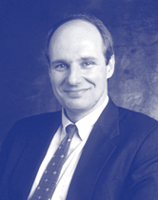|
New Freedom of Public Religion
BY JOHN WITTE JR.
Jonas Robitscher Professor of Law and director of both
the Law and Religion Program and the Center for the Interdisciplinary
Study of Religion
The civic catechisms of our day still celebrate Thomas Jefferson’s
experiment in religious freedom. Religion must be "a concern
purely between our God and our consciences," Jefferson wrote
in 1802. Politics must be conducted with "a wall of separation
between church and state." "Public Religion" is a
threat to civil society and thus must be discouraged.
These Jeffersonian maxims remain for many today the cardinal axioms
of a unique American logic of religious freedom: religious privatization
is the bargain we must strike to attain religious freedom for all,
and a wall of separation is the barrier we must build to contain
religious bigotry for good.
Separation of church and state was certainly part of American law
when many of today’s civic opinion-makers were in school.
In 1940 and 1947, the U.S. Supreme Court for the first time used
the First Amendment religion clauses to declare local laws unconstitutional.
In more than thirty cases from 1947 to 1985, the court purged public
schools of their traditional religious teachings and cut religious
schools from their traditional state patronage.
After forty years of such cases, it is no surprise that many now
think that Jefferson’s words are enshrined in the First Amendment
itself. It is often disconcerting for readers to discover that the
First Amendment is much more restrained and ambiguous: "Congress
shall make no law respecting an establishment of religion, or prohibiting
the free exercise thereof."
During the past two decades, the Supreme Court has abandoned much
of its earlier separationism and reversed some of its harshest cases.
In a dozen cases, the court has upheld government policies that
support the public access, activities, and funding of religious
groups—so long as these groups are voluntarily convened and
so long as nonreligious groups are treated the same way.
Hence, religious counselors could be funded as part of a broader
federal family-counseling program. Religious student groups could
have equal access to public classrooms and state funds that were
available to nonreligious student groups. Religious schools were
just as entitled to participate in a state-sponsored school-voucher
program as other private schools.
The Supreme Court has defended these holdings on wide-ranging constitutional
grounds and has not yet settled on a consistent new logic. One common
teaching of these recent cases, however, is that public religion
must be as free as private religion—not because the religious
groups in these cases are in fact nonreligious, nonsectarian, or
part of the cultural mainstream. To the contrary, these public groups
and activities deserve to be free because they are religious, because
they engage in sectarian practices, and because they sometimes take
their stands above, beyond, and against the cultural mainstream.
A second teaching of these cases is that the freedom of public
religion sometimes requires the support of the state. Today’s
state is not the distant, quiet sovereign of Jefferson’s day,
from which separation was both natural and easy. Today’s state
is an intensely active sovereign from which complete separation
is impossible.
|
|

|
| |
| John Witte Jr., a specialist
in legal history, marriage, and religious liberty, has published 120
professional articles and 12 books, most recently Law and Protestantism:
The Legal Teachings of the Lutheran Reformation (2002). He has lectured
and convened major conferences throughout North America, Western Europe,
Israel, and South Africa. Witte has been selected as the Most Outstanding
Professor by Emory law students eight times and has won seven other
major awards for his teaching and research |
 |
Few religious bodies now can avoid contact with the modern welfare state’s
pervasive regulations; both confrontation and cooperation with government
are virtually inevitable.
When a state’s regulation imposes too heavy a burden on a particular
religion, the free-exercise clause provides a pathway to relief. When
a state’s appropriation imparts too generous a benefit to individual
religions, the establishment clause provides a pathway to dissent. However,
when a general government scheme provides public religious groups and
activities with the same benefits afforded to all other eligible recipients,
constitutional objections now are rarely availing.
A third teaching of these cases is that freedom of public religion also
requires freedom from public religion. Government must strike a balance
between coercion and freedom; the state cannot force citizens to participate
in religious ceremonies and subsidies they find odious.
Still, it is one thing to outlaw Christian prayers and broadcasted Bible
readings from public schools; after all, students are compelled to be
there. It is quite another thing to ban moments of silence and private
religious speech in these same public schools.
A final teaching of these cases is that freedom of public religion is
no longer tantamount to establishment of a common religion.
Government support of a common civil religion might have been defensible
in earlier times of religious homogeneity, but it is no longer in these
times of religious pluralism.
Today, our public religion must thus be a collection of particular religions,
not the combination of religious particulars. It must be a process of
open religious discourse, not a product of ecumenical distillation. All
religious voices, visions, and values must be heard and deliberated in
the public square.
Some conservative Protestants and Catholics today have seized on this
new insight better than most. Their recent rise to prominence in public
and political processes should not be met with reflexive incantation of
Jefferson’s mythical wall of separation.
The rise of the Christian right should be met with the equally strong
rise of the Christian left, of the Christian middle, and of sundry Jewish,
Muslim, Hindu, Buddhist, and other religious groups who test and contest
its premises, prescriptions, and policies. That is how a healthy democracy
works.
|

